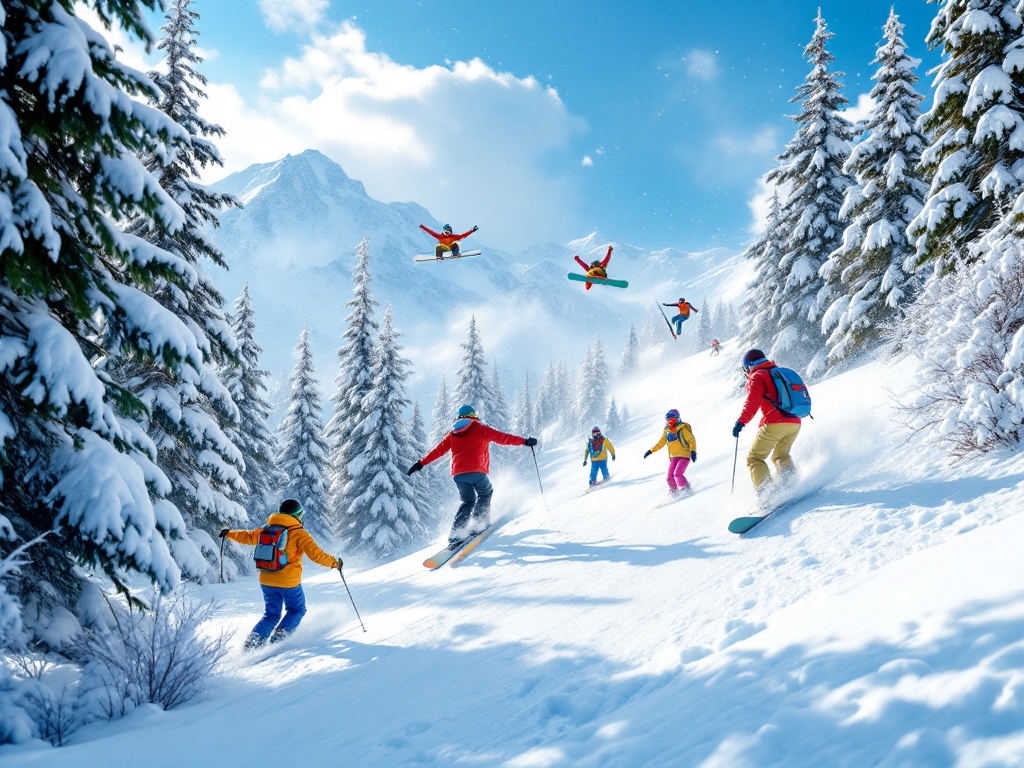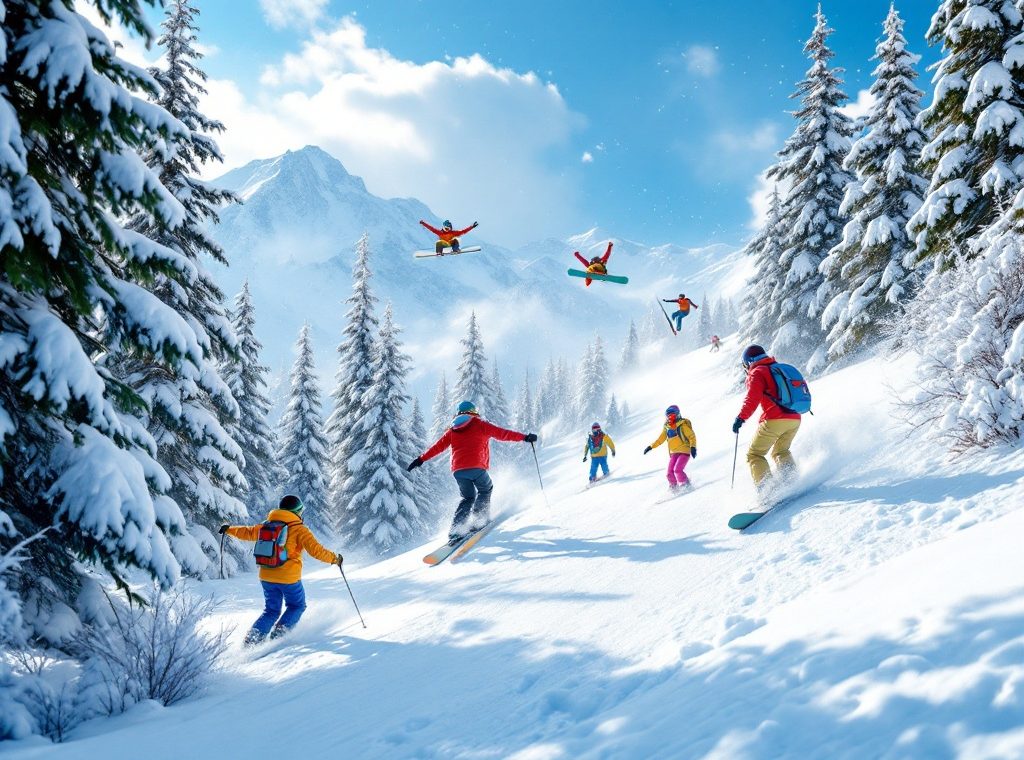Winter Sports Travel Insurance: Stay Safe While Playing in the Snow
Planning an exhilarating winter sports trip? Don’t let unexpected injuries, lost gear, or trip cancellations ruin your adventure. Specialized winter sports travel insurance offers crucial protection for skiers, snowboarders, and other winter sports enthusiasts, covering medical expenses, equipment loss, and even piste closures. Compare policies today and carve worry-free tracks down the slopes this winter!
Important information

- Winter sports travel insurance covers common risks: injuries, lost/damaged equipment, and trip cancellations/interruptions.
- Coverage includes medical expenses, emergency evacuation, gear replacement, and piste closures. Liability protection is also often included.
- Policy costs depend on trip length and coverage levels. Compare policies and read the fine print before buying.
- Extreme sports like heli-skiing or off-piste skiing may require additional coverage. Accidents under the influence of drugs or alcohol are typically excluded.
- Buy insurance right after booking your trip. Disclose pre-existing conditions to ensure proper coverage.
Understanding Winter Sports Travel Insurance
Planning a winter sports adventure? Protect yourself with specialized travel insurance. It covers common winter sports risks, like skiing injuries, lost or damaged equipment, and trip cancellations. This coverage can save you significant money on medical expenses, gear replacement, and unexpected travel changes. Costs vary depending on factors like trip length and coverage levels. Longer trips and more extensive coverage typically result in higher premiums. Compare policies to find the best fit for your needs and budget. Crucially, read the fine print before purchasing to understand the details, coverage limits, and exclusions. This ensures a worry-free trip, letting you focus on the slopes.
Why Choose Specialized Winter Sports Travel Insurance?
- Covers common winter sports risks, including injuries, equipment loss or damage, and trip cancellations.
- Offers financial protection for medical expenses, gear replacement, and unexpected travel changes.
Understanding Insurance Costs and Coverage
- Costs depend on trip length and chosen coverage levels.
- Longer trips and more extensive coverage usually mean higher premiums.
- Compare different policies to find the best value for your needs and budget.
Before purchasing any policy, carefully review the terms and conditions, including coverage limits and exclusions, to ensure a worry-free winter sports experience.
Why Winter Sports Travel Insurance is Essential
Winter sports travel insurance is crucial. It safeguards you from unexpected financial burdens, like accidents, injuries, and steep medical bills. This specialized coverage offers valuable peace of mind by also addressing trip cancellations and interruptions, along with lost or damaged equipment. Without it, you risk substantial expenses for medical treatment and gear replacement. Skiers and snowboarders especially benefit from this type of insurance.
Coverage Benefits
- Covers medical costs, including emergency care, hospitalization, and even evacuation.
- Protects your equipment against loss or damage.
- Covers trip interruptions.
Why You Need It
This insurance acts as a safety net against the unpredictable nature of winter sports. Whether it’s an injury, sudden illness, or an unforeseen trip disruption, you’re covered. From medical expenses and emergency evacuation to trip cancellations, this insurance shields you from financial strain, ensuring unforeseen events don’t derail your winter adventure.
Importance of Coverage for Skiing and Snowboarding
Winter sports travel insurance is crucial for ski and snowboard trips, offering specialized coverage for on-slope accidents and other travel-related issues. It protects you from the financial burdens of medical emergencies, repatriation, and trip interruptions. Because winter sports inherently involve risks, this protection is essential for safeguarding travelers.
Protection Against Unexpected Incidents
Winter sports travel insurance is a must-have for any enthusiast. It protects you from a range of unexpected issues. Coverage includes slope injuries, blizzard-related cancellations, and lost or stolen equipment. Even piste closures and misplaced ski passes are covered. This insurance offers invaluable peace of mind, ensuring unforeseen events don’t derail your trip. It’s a wise investment for a worry-free winter adventure.
What’s Covered by Winter Sports Travel Insurance?
Winter sports travel insurance offers crucial protection against various unforeseen events. It covers medical emergencies, piste closures, and lost ski passes, ensuring you’re prepared for common winter sports mishaps.
The policy safeguards against trip cancellations and interruptions, protecting your investment and allowing for worry-free travel planning. It also covers your equipment against loss, theft, or damage, ensuring you’re not left stranded without essential gear.
Emergency evacuation and rescue services are covered, both on and off the slopes, providing an essential safety net during your adventures. Liability protection is included, covering medical costs for injuries sustained while participating in winter sports, offering financial security in case of accidents.
Knowing your equipment and trip are protected against unforeseen circumstances, such as bad weather delays or cancellations, provides invaluable peace of mind. This comprehensive coverage prioritizes your well-being and ensures a safe and worry-free winter sports experience, getting you home should any issues arise.
Medical Emergencies and Assistance
Winter sports travel insurance offers crucial coverage for medical expenses, including dental care, in case of accidents or illnesses. Furthermore, these policies often cover emergency evacuation and medically necessary repatriation to guarantee a safe return home. Protect yourself on the slopes with travel insurance.
Emergency Evacuation and Rescue Operations
Winter sports travel insurance is crucial for any winter sports enthusiast. It provides coverage for emergency medical evacuations, ensuring you are transported to the nearest suitable medical facility.
Many winter sports travel insurance policies offer search and rescue coverage, which is particularly important for those engaging in higher-risk activities like off-piste skiing or snowboarding. Rescues in remote or difficult-to-access areas can be extremely expensive, but having insurance provides peace of mind knowing you are protected.
Before you head out on your winter adventure, carefully review your policy details. Pay close attention to the specifics of your evacuation and rescue coverage, including any limits or procedures.
Trip Cancellation and Interruption Coverage
Travel insurance offers crucial protection for your trip. Cancellation coverage safeguards your prepaid expenses, reimbursing you for non-refundable costs like flights and accommodations if unforeseen circumstances, such as illness, injury, or severe weather, force cancellation. Interruption coverage provides similar reimbursement if a natural disaster or family emergency cuts your trip short. Both options offer financial peace of mind, protecting your trip and your wallet.
Equipment Loss, Theft, and Damage
Protect your winter sports equipment with travel insurance. It safeguards against loss, theft, and damage. Lost skis or a stolen snowboard? You’re covered. Equipment damaged in an accident? Also covered. Check your policy for coverage limits.
Liability Protection for Unplanned Incidents
Slope-side liability coverage is essential. It safeguards your finances if you inadvertently injure another person or damage their belongings, for example, in a collision with a fellow skier or snowboarder. This protection extends to damage of rented equipment and even accidental property damage at the resort.
Coverage for Piste Closures and Lost Ski Passes
Losing your ski pass can ruin your vacation and impact your finances. Fortunately, winter sports travel insurance often covers the cost of replacing lost or stolen passes. It can also reimburse you for pre-paid activities like ski lessons or equipment rentals if the slopes close unexpectedly due to bad weather or avalanche risk. Review your policy details for specific limits and conditions to ensure you have adequate coverage.
What Activities Are Considered Winter Sports?
Winter sports offer a thrilling array of activities, from snowy slopes to icy adventures. Skiing and snowboarding are popular choices for gliding down groomed runs. For those seeking alternative icy experiences, ice skating, snowmobiling, and sledding provide exciting ways to enjoy the winter wonderland. Some insurance policies extend coverage to off-piste skiing and snowboarding, and may even include ice climbing. Always review your policy documents for specific coverage details. High-risk activities such as heli-skiing often require supplementary insurance, so carefully examine your policy details.
On-Piste vs. Off-Piste Skiing and Snowboarding
Most skiers and snowboarders stay within the resort’s marked boundaries, known as on-piste, and standard travel insurance typically covers them. For these skiers and snowboarders, a standard travel insurance policy offers sufficient protection.
Venturing beyond these limits into ungroomed, unmarked terrain is called off-piste and often requires specialized insurance for adequate protection. Serious adventurers should consider a dedicated policy to address the increased risks. Choosing the right coverage is crucial for peace of mind.
Other Covered Winter Activities
Winter sports travel insurance offers broad protection beyond just skiing and snowboarding. It typically covers activities like ice skating, snowmobiling, and ice hockey. Thrill-seekers will be pleased to know that bobsledding and tobogganing are often included, as is the gentler pursuit of snowshoeing. Even winter hiking and cross-country skiing can be covered under some policies. Remember to review your specific policy details to confirm which activities are included.
- Ice skating,
- Snowmobiling,
- Ice hockey,
- Bobsledding,
- Tobogganing,
- Snowshoeing,
- Winter hiking,
- Cross-country skiing.
High-Risk and Extreme Winter Sports
Carefully review your existing insurance coverage. Note both inclusions and exclusions to understand what activities are covered.
Identify high-risk winter sports you plan to participate in, such as heli-skiing, ice climbing, backcountry snowboarding, off-trail snowmobiling, or BASE jumping.
If your current policy doesn’t cover these extreme activities, secure a supplemental insurance policy. This specialized coverage offers protection for inherent risks associated with these pursuits.
Having the appropriate insurance provides financial security, covering potential medical expenses, rescue operations, and other unforeseen costs related to your winter adventures.
What Might Be Excluded from Winter Sports Travel Insurance?
Driving under the influence will invalidate your accident coverage. Negligently damaged equipment isn’t covered either. Ignoring government travel advisories can also void your policy.
Thrill-seeking winter sports like heli-skiing may offer only limited coverage, or none at all. Similarly, activities like ice climbing and other high-risk pursuits might be excluded. Review your policy details to understand exactly what’s covered and what’s not.
Accidents Under the Influence
Winter sports travel insurance typically excludes accidents involving alcohol or drugs. This applies to injuries of any severity, from minor mishaps to major slope incidents. Therefore, avoid skiing or snowboarding under the influence, as your coverage could be voided.
Equipment Negligence
Negligence can void your equipment coverage. Insurers often exclude claims for items lost or damaged due to negligence, such as leaving skis unattended or failing to secure gear properly. Carefully review your policy’s negligence exclusions to understand your coverage limitations.
Travelling Against Government Advice
Ignoring government travel advisories, especially “Do Not Travel” warnings, can invalidate your winter sports travel insurance. These warnings signify considerable safety and security risks at your destination. Disregarding them may lead to being stranded without insurance coverage during emergencies, like needing medical evacuation. Checking official government travel advisories before your trip is crucial for your safety and insurance validity, ensuring a secure and covered winter sports experience.
Extreme Winter Sports Exclusions
Standard winter sports travel insurance often excludes extreme activities. These can include heli-skiing, ice climbing, and off-piste touring. These activities require specialized coverage, so carefully review your policy for exclusions. Participating in uncovered activities could leave you uninsured in case of injury. For complete protection during extreme winter sports, a specialized policy is essential.
When Should You Buy Winter Sports Travel Insurance?
Secure your winter sports travel insurance immediately after booking your trip. This crucial step safeguards you from unforeseen issues like trip cancellations or pre-departure medical emergencies. Purchasing your insurance early ensures comprehensive coverage and offers peace of mind. When selecting a policy, carefully consider any pre-existing medical conditions and thoroughly review the policy details.
Best Time to Purchase Coverage
Purchase travel insurance right after booking your winter sports trip to protect yourself from unexpected cancellations or interruptions. Early coverage is essential for comprehensive protection and peace of mind against any unforeseen circumstances.
Considerations for Pre-Existing Medical Conditions
Disclose any pre-existing medical conditions to your insurance provider, as coverage varies significantly. Some companies cover stable conditions, while others may not. Carefully review your policy for specific details regarding pre-existing condition coverage to understand your benefits and avoid potential claim issues.
Comparing Winter Sports Insurance Policies
Winter sports travel insurance caters to various travel styles and needs:
- Individual policies: Ideal for solo travelers.
- Joint policies: Cover two people traveling together.
- Family policies: Include coverage for children.
Choose the right policy type based on your travel frequency:
- Annual multi-trip policies: Best for frequent skiers and snowboarders taking multiple trips within a year.
- Single-trip policies: Perfect for one-off winter excursions.
Consider optional add-ons like equipment protection or off-piste coverage to enhance your policy.
When selecting a policy, evaluate the number of travelers, your trip frequency, and any specific requirements. Comparing different policies ensures you find the ideal coverage for your winter adventures.
Individual, Joint, and Family Policies
Travel insurance offers a range of coverage options to suit different travel needs. Individuals traveling alone can select individual policies, while joint coverage caters to couples or groups of friends. For families, family policies provide comprehensive coverage for two adults and their dependent children under a single plan. Finding the right policy for your travel group is easy with the varied options available.
Annual Multi-Trip vs. Single Trip Policies
Annual multi-trip insurance is a cost-effective choice for frequent travelers.
A single-trip policy offers ideal coverage for individuals embarking on one trip, such as a winter sports adventure.
The best insurance option depends on how often you travel.
Optional Policy Add-Ons
Tailor your travel insurance with optional extras to suit your specific needs. Enhance your policy with these additions:
- Hiking Coverage: safeguard yourself during summer hikes.
- Gadget Insurance: protect your valuable electronics.
- Increased Baggage Allowance: ideal for heavy packers.
- Specific Equipment Coverage: cover cameras, laptops, and other valuable items.
- Boosted Medical Coverage and Hospital Cash Benefits: ensure comprehensive medical protection and financial assistance during hospitalization.
- Travel Disruption Coverage: protect yourself against missed connections or supplier insolvency.
These add-ons provide valuable protection, ensuring a worry-free trip.
Claims Process for Winter Sports Travel Insurance
After an incident, promptly file a claim with your winter sports travel insurer.
Gather essential documentation such as medical reports, receipts, and, if relevant, a police report.
Complete the insurer’s claim form and submit it along with your supporting documents.
Maintain open communication with your insurer throughout the claims process.
How to File a Claim Successfully
Following any incident, promptly contact your insurance company.
Gather essential documentation such as medical and police reports, along with any relevant receipts.
Complete the claim form thoroughly and accurately.
Should they require further information, provide it swiftly.
Your quick response is vital.
Common Challenges and Solutions
Insufficient documentation, such as missing medical or police reports, can create real headaches. Meticulous record-keeping is crucial, so document everything thoroughly.
Another potential issue arises from claims for uncovered services. For instance, off-piste skiing without a guide is frequently excluded. Carefully review these exclusions before purchasing a policy.
Pre-existing conditions can also lead to claim denials. However, upfront disclosure of these conditions during the purchase process can prevent such rejections.


















